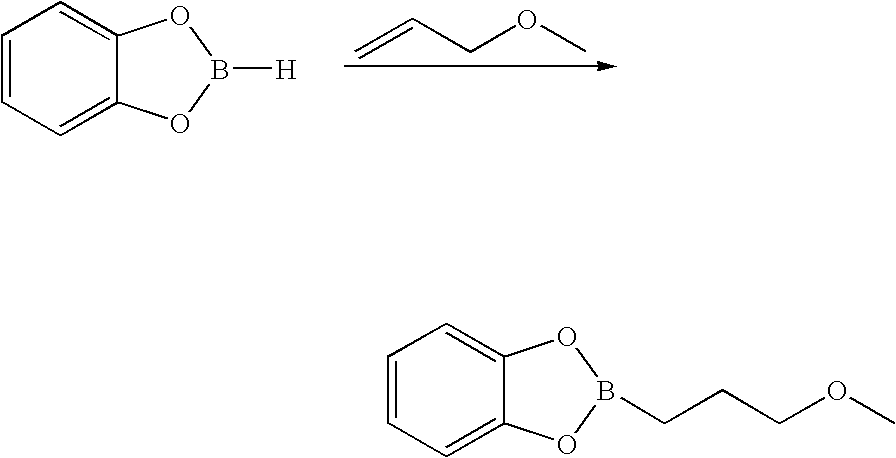Methods for synthesizing organoboronic compounds and products thereof
a technology of organoboronic acid and organic compounds, applied in the field of organoboronic acid, can solve the problems of failure of purification techniques to produce very high purity salts, and inability to obtain high purity salts, etc., and achieve rapid decomposition and increase the stability of organoboronic acid. , the effect of reducing the resistance to deboronation
- Summary
- Abstract
- Description
- Claims
- Application Information
AI Technical Summary
Benefits of technology
Problems solved by technology
Method used
Image
Examples
example 1
Synthesis of TRI 50D
Apparatus
[0378] Throughout the following procedures, standard laboratory glassware and, where appropriate, specialised apparatus for handling and transferring of air sensitive reagents are used.
[0379] All glassware is heated at 140-160° C. for at least 4 hours before use and then cooled either in a desiccator or by assembling hot and purging with a stream of dry nitrogen.
[0380] In the drying procedures of the following examples, products are tested for dryness (including dryness in terms of organic solvent) by observing weight loss on drying. The following procedure was followed to determine loss on drying: a sample was placed in a vacuum drier and dried at 40° C. at 100 mbar for 2 hours. Products are considered dry when the decrease in weight upon drying is less than 0.5% of the total weight of the starting material.
Solvents
[0381] The organic solvents used in the procedures of Examples 1, 2 and 3 are all dry. Suitably, they are dried over sodium...
example 2
Preparation of Sodium Salt of TRI50C (TGN 255)
[0399] 1.5 kg (2.5 mole) TRI50d is dissolved in 10.5 L dichloromethane. 11 L 2% hydrochloric acid is added and the mixture is stirred for at most 30 minutes (optimally about 20 minutes) at room temperature. A precipitate forms in the organic phase. After stirring, the layers are allowed to settle and separated. The aqueous layer is rewashed twice with 2.2 L dichloromethane. The combined organic layers are washed with a solution of 625 g ammonium chloride in 2.25 L water. (The ammonium chloride buffers the pH of the aqueous extractions to be within a range of from about pH 1-2 to about pH 4-5, as strongly acidic conditions might cleave peptide bonds). The organic phase is dried over magnesium sulfate, filtered and the filtrate evaporated to dryness. An assay of the free boronic acid is performed (by the RP HPLC method of Example 5 for at most 30 mins (optionally about 20 min) at room temperature) and the amounts of the solvents and base ...
example 3
Preparation of Calcium Salt of TRI50C (TGN 167)
[0401] 1.5 kg (2.5 mole) TRI50d is dissolved in 10.5 L dichloromethane. 11 L 2% hydrochloric acid is added and the mixture is stirred for at most 30 minutes (optimally about 20 minutes) at room temperature. After stirring the layers are allowed to settle and separated. The aqueous layer is rewashed twice with 2.2 L dichloromethane. The combined organic layers are washed with a solution of 625 g ammonium chloride in 2.25 L water. The organic phase is dried over magnesium sulfate, filtered and the filtrate evaporated to dryness. An assay of the free boronic acid is performed and the amounts of the solvents and base for conversion of the acid to the salt are calculated. If 2.5 mol of the free acid is obtained, the evaporation residue is dissolved in 5 L acetonitrile followed by addition of a suspension of 93 g (1.25 mole) calcium hydroxide in 1 L water. The solution is stirred for two hours at ambient temperature (e.g. 15-30° C., optimall...
PUM
| Property | Measurement | Unit |
|---|---|---|
| molar ratio | aaaaa | aaaaa |
| solubility | aaaaa | aaaaa |
| solubility | aaaaa | aaaaa |
Abstract
Description
Claims
Application Information
 Login to View More
Login to View More - R&D
- Intellectual Property
- Life Sciences
- Materials
- Tech Scout
- Unparalleled Data Quality
- Higher Quality Content
- 60% Fewer Hallucinations
Browse by: Latest US Patents, China's latest patents, Technical Efficacy Thesaurus, Application Domain, Technology Topic, Popular Technical Reports.
© 2025 PatSnap. All rights reserved.Legal|Privacy policy|Modern Slavery Act Transparency Statement|Sitemap|About US| Contact US: help@patsnap.com



